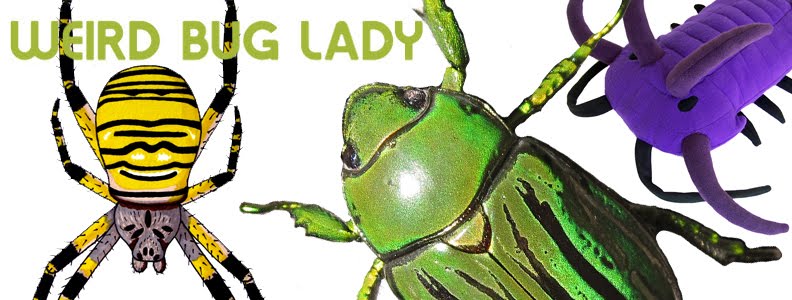 The body scales are partly machine sewn, partly hand sewn, all hand cut of course and positioned to (sort of) alternate like real scales. Got to love the orange tie die fleece I found.
The body scales are partly machine sewn, partly hand sewn, all hand cut of course and positioned to (sort of) alternate like real scales. Got to love the orange tie die fleece I found. To get a sense of the size:
To get a sense of the size: This stuffed specimen is life size, as Panderichthys was about 90 to 130 cm long, a tetrapodomorph from the Devonian period. It had a very large, wide head (I wanted to be sure to portray that) which, among other characters, clearly places it as a transitional form between fish and tetrapods.
This stuffed specimen is life size, as Panderichthys was about 90 to 130 cm long, a tetrapodomorph from the Devonian period. It had a very large, wide head (I wanted to be sure to portray that) which, among other characters, clearly places it as a transitional form between fish and tetrapods.Analysis of the fins of Panderichthys show that the distal radials can in fact be considered homologues of tetrapod digits, suggesting that early tetrapod digits were a reworking of available elements and not a novel invention (Boisevert et al. 2008). Other limb changes, like a flattened and elongated humerus with enlarged ridges, show that fins were starting to become stronger and likely aided in pushing against the substrate (Clack 2009). However the skull was still attached to the pectoral girdle by a series of bones, limiting the head's range of movement (Coates et al. 2008). In many ways, Panderichthys was very much still a fish, but skeletal changes were underway showing a transition to a lifestyle in shallow aquatic environments.
--------------------------------------------
Boisevert, C.A., Mark-Kurik, E. and Ahlberg, P.E. 2008. The pectoral fin of Panderichthys and the origin of digits. Nature 456: 636-638.
Clack, J.A. 2009a The Fin to Limb Transition: New Data, Interpretations, and Hypotheses from Paleontology and Developmental Biology. Annual Review of Earth and Planetary Sciences 37: 153-179.
Coates, M. I., Ruta, M. and Friedman, M. 2008. Ever since Owen: changing perspectives on the early evolution of tetrapods. Annual Review of Ecology, Evolution, and Systematics. 39:571-592.
Clack, J.A. 2009a The Fin to Limb Transition: New Data, Interpretations, and Hypotheses from Paleontology and Developmental Biology. Annual Review of Earth and Planetary Sciences 37: 153-179.
Coates, M. I., Ruta, M. and Friedman, M. 2008. Ever since Owen: changing perspectives on the early evolution of tetrapods. Annual Review of Ecology, Evolution, and Systematics. 39:571-592.











10 comments:
Yeah, well, if fish evolved into tetrapods, then why are there still fish?
*snort* nice one!
But if you're actually serious, I applaud you for your astounding lack of understanding about evolution.
Oh, come on. Nobody's a creationist anymore. *limp-wristed gesture*
We all know this is how it happened: http://www.tchofelich.org/images/Great_Moments.gif
, from the spark to the completed piece of art. Fantastic.
Work from home India
This is amazing! Nice work! These fish have to be my favorite.
I can't believe people still don't understand the most obvious thing in nature...
Man, I love evolution!
yes creaiton is reel theirs a whole museumabout it
people who think evolution beleive in crocoduck
Um, yes, well. I left an award for you on my blog. Your creativity is astounding and weird and I love it.
Melissa
Wow! Neat. Your lungfish is spectacular too!
I saw so much helpful info here!
I came across your amazing work while searching for images of Pompeii worms. I'm a K-5 science teacher in Florida. I'm looking forward to sharing your work with my students. You are a great example of how scientist can be creative in expressing their love of nature through the arts, specially 3D models. I would love to invite an entomologist like you to our school.
Post a Comment